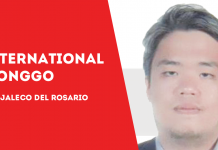 IN THE Western world, there is a concept called the “rainbow coalition.” This concept is based on the notion that non-white people residing in Western countries have shared interests, particularly in relation to the interests of the white majority.
IN THE Western world, there is a concept called the “rainbow coalition.” This concept is based on the notion that non-white people residing in Western countries have shared interests, particularly in relation to the interests of the white majority.
This concept worked fine in the past, but as Western countries become more and more “diverse,” this coalition begins to experience stress, partly because of competition pressures, but also because the rainbow coalition is an artificial construct.
This trend was brought to light by two interesting events recently. The first was an article by Steven Zhou for Vice titled, “How anti-immigrant rhetoric crept into Chinese-Canadian politics.” The article featured anti-immigrant sentiments among Canada’s sizeable Asian population, a large proportion of which are also immigrants themselves.
The second event involved a few naughty comments by his Holiness, the Dalai Lama. His Holiness said that “Europe belongs to Europeans.” He also argued that Europe is “morally responsible” in helping refugees, but added that such refugees must ultimately go home and develop their own countries. Right wing, nationalist groups all over Europe and the United States have latched onto such statements for their soft-power value.
These two event ultimately led people in the Western World to ask the question: Can Asians be racist?
The answer is absolutely.
Japan’s Sakoku policy and North Korea’s Juche ideology are great examples of Asia’s history with ethno-political isolationism. For a more ancient example, there was the Guangzhou massacre carried out by the brave revolutionary-slash-civil service dropout-slash-salt merchant-smuggler Huang Chao against Arab and Persian Merchants during the Tang Dynasty. I can also point out the various ethno-religious conflicts here in South East Asia, most notably the race riots that fractured Singapore from Malaysia
If you want a more recent example, there is the Rohingya crisis in Myanmar and the 2013 Little India riot in Singapore. Even here in jolly Philippines, we make a distinction between Filipino and the Banyaga.
In short, yes, Asians can be racist, but worse than being racist is being racist to other non-whites, particularly in the Western World. Non-white groups being racist to one another damages the rainbow coalition, and run counter to non-white interests, the Western “Progressive Left” might argue.
Does it though?
The Rainbow Coalition was a concept developed around a much larger global assumption that all human beings have shared interest, but looking at the world and world history that is clearly not true. Human beings have tribes and nations, and they each have differing interests.
The Asians in the Western World do not see themselves as part of a Universal Humanity, and in the case of the Chinese Canadians, it seems that they no longer care to be part of the rainbow coalition, which explains the “racist”/anti-immigrant rhetoric.
As for His Holiness, well, no surprise there. He’s an exiled nationalist, and nationalism – or more specifically ethno-nationalism has become somewhat taboo in the Western World.
The greatest lesson about Asian “racism” (and I’m heavily emphasizing the air quotes here) is that it is a concept that originated in the Western World. And judging how most Asian countries (including our own Philippines) look at immigration and humanist abstractions, it’s probably safe to say that most Asians all over the world don’t care to be part of a global rainbow coalition when their own interests are at stake. (jdr456@gmail.com/PN)





